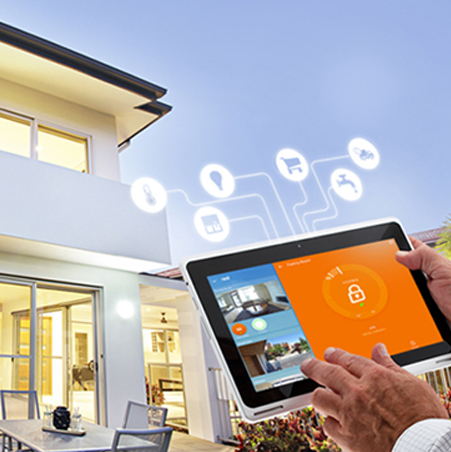

A smart home means your home has a smart home system that connects with your appliances to automate specific tasks and is typically remotely controlled. You can use a smart home system to program your sprinklers, set and monitor your home security system and cameras, or control appliances like your refrigerator or air conditioning and heating.
At Constellation we love how energy-efficient smart homes are, because they save you precious time and money while also conserving energy!

Many Peoples are looking into smart homes ideas, how smart homes work, or specific task automation for benefits like these:
Smart homes allow you to have greater control of your energy use, all while automating things like adjusting temperature, turning on and off lights, opening and closing window treatments, and adjusting irrigation based on the weather.
Smart homes provide insights into energy use that can help you become more energy efficient and mindful of ecological factors.
Smart homes can pinpoint areas where you’re using more energy than you need to, allowing you to cut back in those areas and save money.
And while it might sound like just another passing fad to some, the smart home—like the smartphone—is here to stay. With over 80 million smart home devices delivered worldwide in 2022, some predict that number will grow to over 130 million smart home devices by the end of 2023.
Smart home devices are not always energy efficient, but most can be utilized in ways that help you conserve energy. When you have smart home appliances, lights, or a smart thermostat, you control when and how these will turn on and function. Therefore, you have more control over your energy usage and are more likely to change your energy consumption habits.
When smart homes first became an option, the answer was a bit hazy. But as bigger players join the industry, they’re making it easier for consumers to understand and acquire the technologies needed to get started.
What you need to turn your regular home into a smart home are 1) a Wi-Fi connection, 2) smart home appliances (or smart home devices) and 3) a smart home system to connect, monitor, and control these devices.

A smart device is any electronic device that can be connected to your smart home system, that can interact with other devices, and that can make some decisions on its own. Televisions, stoves, alarm systems, doorbells, garage doors and stereos are examples of smart devices. Smart devices can be bought separately and over time, making it easy to slowly transform your house into a smart home.
The smart home system is the “hub,” so to speak, of your smart home. Either through a wall-mounted unit or software accessible via the Internet, a smart home system gathers unique information from each of your smart devices or appliances and allows you to control all your devices in one place. Because the smart home market is still emerging, there are several different options for smart home systems or home automation hubs, most of which are only compatible with specific other systems—so be sure to confirm compatibility before purchasing.
The short answer is either “all at once” or “one step at a time.” Still, there are a few things everyone will have to do in order to get ready for their new-and-improved home appliances and smart devices.
Upgrade your Wi-Fi. Since all smart home devices use the Internet to communicate, you’ll want to make sure you have Wi-Fi strong enough to handle information sharing. For larger homes, you may want to even consider getting multiple routers.
Do your research. There are so many smart systems and smart home devices available that it’s a smart idea—pun intended—to familiarize yourself with a few different options before settling on one.
Identify your needs. Figure out exactly what you’re looking for from a smart home, and then pick the areas you want to start addressing right now. From there, it’s a cinch to pull from your research the smart home system and smart devices and appliances that will meet your needs. There’s nothing worse than buying a fancy new gadget only to have it gathering dust in a corner a few weeks later because it’s not really something you need right now--especially a costly one!
If you’re looking around your house wondering what regular devices you have now that can be turned into a smart device, it’s better to ask “What can’t be turned into a smart device?” If it can be plugged in, chances are there’s a company out there making a smart version of it. To get you started, here’s a short list of smart home ideas that we here at Constellation really love:
Keep your home safe with smart locks. Replace your current front-door lock with a smart lock to lock and unlock your door remotely, check to make sure you locked the door after you’ve already left, and keep a record of who has come and gone.
Monitor your home with smart security alerts. A multitude of smart home devices can alert you to safety or security issues remotely. Get alerts no matter where you are for leaks, for leaving the garage door open, for smoke, for when someone rings your doorbell, or for if you left something plugged in that really should have been turned off before you left the house.
Manage your home temperature and save energy with a smart thermostat. A smart thermostat can learn your habits and automatically adjust the temperature based on your unique schedule. It also lets you manually and remotely adjust temperatures through an app.
Delegate tasks through a smart assistant. A virtual assistant—think Google Home or Amazon Echo—allows you to use voice commands to do things such as turn on music, search the Web and control your household smart devices.
Streamline your chores with smart appliances. Smart TVs, dishwashers, refrigerators, and washers and dryers all allow remote access and control, and can alert you to information that’s relevant to each appliance. For example, your washing machine can detect when energy consumption is the lowest in your area and turn on during that time, or your refrigerator can scan your groceries, letting you know when the eggs are about to expire or how much milk you have left!
Control your home lighting with smart light bulbs. Smart lights allow you to control the lighting in every room of your house from your mobile device. Did your seven-year-old forget to turn off the lights in the kitchen? You can do it on the way to school right from your phone. Or configure your lights to turn on and off at set times, and never worry again if someone forgot to turn off the lights before you leave for the day.
Get the best of both worlds with a smart and sustainable home. For example, installing an electric car charging station in your garage allows you to upgrade your home and also lean into a more sustainable lifestyle!
The new world of smart home technology is an exciting one, and the possibilities and combinations are becoming endless. As the smart home industry continues to grow, so will the offerings available and their impact on your daily life.